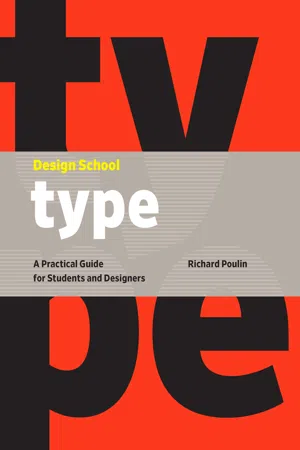
- 240 pages
- English
- ePUB (mobile friendly)
- Available on iOS & Android
About this book
Design School: Type is an in-depth guide to the rules and practices of typography, you’ll learn the essential skills of the professional typographer in the detail.
Searching for a way to increase your skills as a typographer? This instructive guide, specially designed for students, recent graduates, and self-taught designers is a comprehensive introduction to typography. These guided lessons offer in-depth analysis of all the major areas of theory and practice used by experienced professional designers.
Each section is interspersed with tests designed to help you retain the information they've covered, and a selection of relevant support files in popular design software formats so you can test yourself with provided demos. This guide to the rules and practices of typography avoids the temptation to stray into other areas of design technique, preferring to cover the essential skills of the professional typographer in the detail required to arm students and graduates with the knowledge needed for a successful start to their chosen career.
Frequently asked questions
- Essential is ideal for learners and professionals who enjoy exploring a wide range of subjects. Access the Essential Library with 800,000+ trusted titles and best-sellers across business, personal growth, and the humanities. Includes unlimited reading time and Standard Read Aloud voice.
- Complete: Perfect for advanced learners and researchers needing full, unrestricted access. Unlock 1.4M+ books across hundreds of subjects, including academic and specialized titles. The Complete Plan also includes advanced features like Premium Read Aloud and Research Assistant.
Please note we cannot support devices running on iOS 13 and Android 7 or earlier. Learn more about using the app.
Information

Section 1
Type Classifications

Jenson (1471)
Nicolas Jenson (French, 1420–1480)

Nicolas Jenson
(French, 1420–1480)

Table of contents
- Cover
- Title Page
- Table of Contents
- Introduction
- 1. Type Classifications
- 2. Terminology
- 3. Characters and Glyphs
- 4. Typographic Principles
- 5. Selecting Typefaces
- 6. Typography in Practice
- Test your Knowledge Answers
- Resources
- Bibliography
- Index
- Credits
- Copyright